Blog Post #17: Related Work on Nella Larsen-The Passing
I found an academic journal entitled The insoluble conflict of the racial divide – white and black – in Nella Larsen’s novels Passing and Quicksand written by Luciane Oliveira Müller. Even though I only read the novel The Passing by Nella Larsen, I am interested in other works of Larsen. Thus, I think this is a great article for me to get to know more works from Larsen, her style of writing, and comparison and contrast between The Passing and her other novels.
image source: Passing, Quicksand
Müller’s academic journal discusses two novel, Passing and Quicksand, are written by Nella Larsen during the Harlem Renaissance with a focus on racial division. Müller claims, “ the experience of ‘passing’ constituted one of the privileged topics in several novels by Afro-American writers.” In addition, Müller uses other outside sources in relation to racial and identity conflicts to further analyze psychologically and culturally. Müller shows the racial division between black and white by analyzing the difficulties that the characters in the novel faces and the ways that they deal with it.
In the introduction of this journal, Müller gives the social context of Larsen and highlights the African-American people were “separate but equal” during that special time period, just as what we mentioned in class. “Much of the racial problem of the United States was due to the ignorance of whites of the true character of blacks, and ignorance of blacks of their own true qualities as people. The production of art and literature would serve to lift this cloud of ignorance by demonstrating to the white world that blacks could achieve on the highest level, measured by Euro-American standards.”
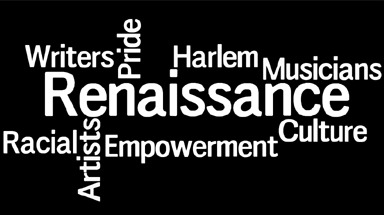
Larsen emphasizes on the idea of race and ethnicity. She draws social and cultural issues in the racial term. Larsen uses the character, Clare, as a perfect example of a sense of racial disorientation during this special time period. Personally, I think the title of this novel not only try to explain Carle as a black woman passing into a white person, but also as a part of the white society pass to black and look for her sense of belongingness.
In this academic journal, Müller explains the meaning of the title of this novel, The Passing. In my opinion, even though the word “passing” is commonly used by people, as the title of this novel, there is special meaning behind it. I completely agree with Müller’s point of view and it really helps me to understand the novel even further. Müller points out, “In this sense, it is possible to say that, in a society in which appearances are worth more than essence, to show a real self might require courage, which is something that just few people are endowed with. Thus, it is convenient for an individual to pass for someone that follows the patterns of a determined framework in order to be accepted. Nevertheless, Larsen exposed in her novel the tragedy that ‘passing’ can bring about. Even if the characters might present a positive value associated to resistance, this experience also brings to the individual a feeling of void in terms of belongingness.”
Blog Post #16: In-Depth Reading-The Passing
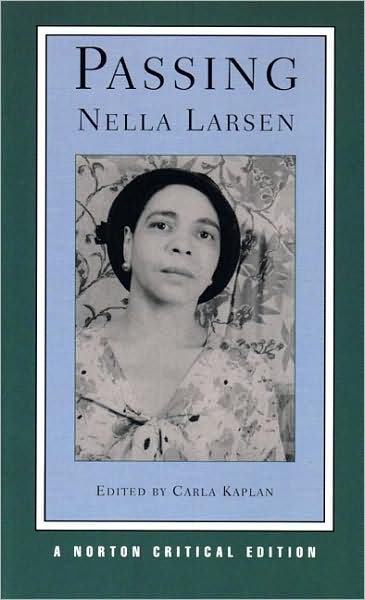
As I am reading the novel entitled The Passing by Nella Larsen, even though I did not finish reading the book, I think this is such a meaningful and powerful book. There are so many scenes worthwhile to do an in-depth reading with. My favorite scene is the first chapter of the first book. When I just start reading it, the beginning of the novel confused me a little bit. The author begins the story with a bunch of mail and Irene’s flashback to her childhood without giving any background or setting. However, the more I read, the more I like the start of this chapter.
The story beings, “It was the last letter in Irene Redfield’s little pile of morning mail. After her other ordinary and clearly directed letters the long envelope of thin Italian paper with its almost illegible scrawl seemed out of place and alien.” I love how this novel starts with a detail description about Irene’s mail which helps to emphasize it. It really helps the reader form a clear picture in mind of these mails and envelopes.
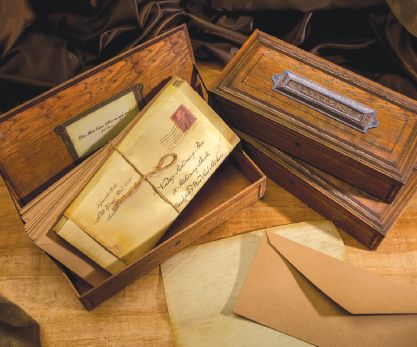
And the story continues, “And there was, too, something mysterious and slightly furtive about it. A thin sly thing which bore no return address to betray the sender. Not that she hadn’t immediately known who its sender was. Some two years ago she had one very like it in outward appearance. Furtive, but yet in some peculiar, determined way a little flaunting. Purple ink. Foreign paper of extraordinary size.” Again, the author gives detailed descriptions of the letter and points out that the sender is unknown. Both the details and the unknown sender make me curious and wants to keep reading this story to find out what is going to happen next. The first time I read this beginning really draws me into the story. Later on, when I came back to the beginning, I found out that “This, she reflected, was a piece with all that she knew of Clare Kendry. Stepping always on the edge of danger” which foreshadows Clare is going to fall from the window and highlights her identity as a white.
Besides the beginning of the novel, the flashback of her childhood shed light on two characters, Brian Junior and Ted, which highlight the idea of parenting. Different people with different characteristics can influence their children in so many different ways. I think it is very interesting to place Irene’s childhood flashback at the beginning. It is a great way to attract the reader’s attention and to introduce the characteristics of some of the characters in the novel.
Blog Post #15: Archival Exploration-Mary Rowlandson Captivity Narrative
I read a slave narrative for another class called The Interesting Narrative of the Life of Olaudah Equiano, or Gustavus Vassa, the African. Written by Himself. Both the slave narratives from Equiano and Harriet Jacobs makes me very interested in slave narratives written by female authors. Since I do not know any female authors on slave narratives, before I do research by using the “Resources for Digital Edition”, I searched on google for the names of female authors on slave narratives. I found a female author who is named Mary Rowlandson. Then, I searched “Mary Rowlandson” on Library of Congress. I found a photo of The Captivity of Mrs. Rowlandson and her captivity narrative entitled Narrative of the Captivity and Restoration of Mrs. Mary Rowlandson.
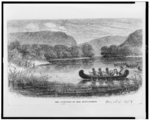
Mary Rowlandson is a colonial American woman who was captured by native Americans. She writes her own captivity narrative six years after her restoration. During King Philip’s War, she was captured in Massachusetts and separated from her family. She points out how the Indians treat her badly and give limited food to her and her little daughter and her little daughter ends up dead. She is tortured by the Indians and almost hopeless for multiple times. However, she received a Bible from one of the Indians, and the Bible gives Rowlandson strength for her to suffer through her captivity.
I would like to focus on 19th-century slave/captivity narrative because, to me, they are very special and based on true experienced that someone actually went through. I am interested in comparing the slave narrative by Harriet Jacobs with the captivity narrative by Mary Rowlandson.
Blog Post #14: Death by Drowning? Why Untimely Death?-The Awakening
At the end of this novel, Edna ends her life by drowning in the sea. To be honest, while I was reading, I was really surprised Edna ends up commit suicide. I felt so bad for her, I do not think that she suppose to give up her life. Even though during that particular time period, the opportunity for women is not as much as nowadays; there are still possibilities for her to enjoy her life. Personally, I think Edna gives up her life is not a wise choice.

Edna’s death can be viewed from different angles. From one point, Edna’s suicide is a way to escape all the unhappiness that she has faced. Edna faces too much pressure of all the social expectations as a wife, a mother, and a woman. Even though committing suicide is not the best choice for Edna, that is probably a good way for her to get rid of all the pressures. She chooses to end her life because her life is no longer enjoyable.
Another way to look at Edna’s death is her act of rebellion. She wants to control her life in her own hand rather than controlled by her husband or judged by the social expectations. She wants absolute freedom deeply in her mind. She does not want to follow the rules to be a perfect 19-century woman, committing suicide is a way for her to show her rebellion to the world. No matter how readers look at Edna’s suicide; it is her special way to challenge the society in a silent.
The sea in this novel represents Edna’s liberation and escape. The first time Edna experience freedom is when she swims in the sea. She enjoys that she is able to control her own body and do whatever her heart desires. In a way, the sea also serves as a reminder for Edna to gain her own freedom, liberation, and to find her true happiness. At the end, Edna commits suicide by drowning which also draw connections with her discovery of her own freedom for the first time.
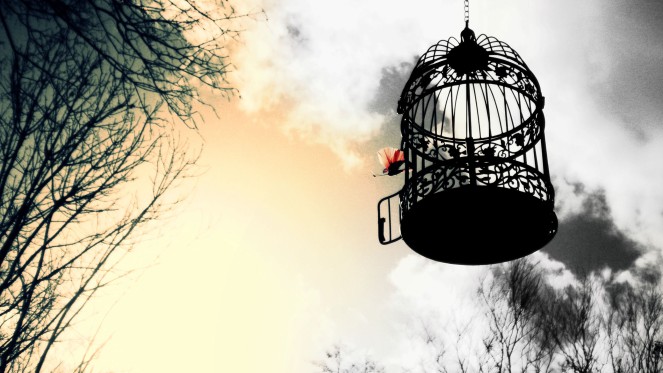
By reading these novels, I realized that there are so many women in the nineteenth and early twentieth-century fiction meet untimely deaths. I think there are so many reasons. The life expectancy is low back in the days, therefore, people usually die early. However, there are other reasons for women to meet unnatural death; many women lose their life while giving birth or other epidemic diseases. Some women just life Edna; never have the chance to realize they are actually not happy with their current situation. Thus, the long-term depression can play a significant role for them to meet their untimely deaths.
Blog Post #13: Novel’s Title&Women in the Novel-The Awakening
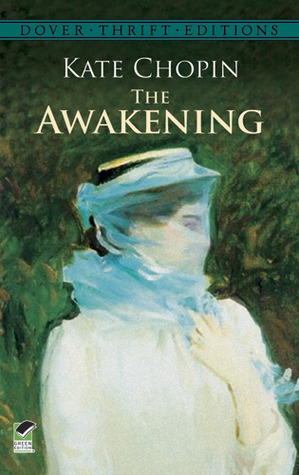
My favorite part of The Awakening by Kate Chopin is the title; it is the illumination of the entire novel. The main character named Edna, who is a mother of two children and the wife of Léonce Pontellier. The title represents the awakening of Edna’s own spiritual journey. At first, Edna acts as a traditional 19-century woman, who takes care of the family and children. Even though Edna behaves as what the society expects, she feels oppressed, pressured, and unhappy. When she swims for the first time, she feels free, released, and happy; she enjoys something that she never experienced before. This makes her want to look for more freedom.
I believe that two of her friends, Adele Ratignole and Madame Reisz are two extreme versions of Edna. Adele Ratigonle always follows the social expectations perfectly, she is almost like a perfect model of 19-century women. Adele dedicates her entire life to her family and takes good care of the family members. As Edna’s good friend, in the story, she serves as a reminder for Edna of the duties as a mother and wife. Adele is the “perfect” version of Edna who, takes care of the family dutifully. Edna knows that Adele is the version that she is trying to achieve.
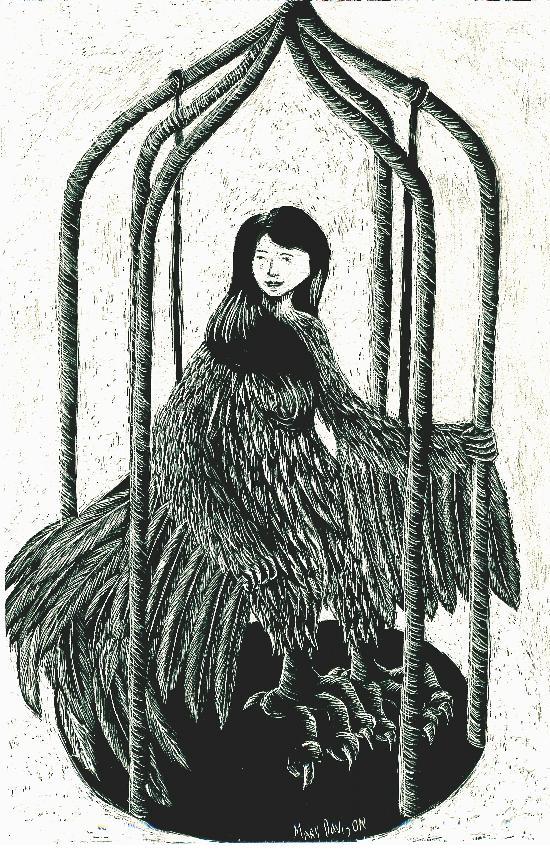
In contrary, Madame Reisz takes the completely opposite side. She is a great pianist, who focus on music and her own feeling rather than social expectations. In Madame Reisz’s own world, she is completely free, happy, and she lives for herself. That is the reason that makes Edna admires her at the same time, Edna wishes to be as her. Madame Reisz is the version that Edna truly wants to be without considering or worrying about anything. Madame Reisz also serves as an inspiration of Edna’s own awakening.
Both of her friends not only give Edna great impact in her further life but also enrich the title, the Awakening, to challenge all kinds of social expectations. Books like The Coquette, American Indian Stories, and The Wild Wild World in the previous blog posts all have elements about women challenge the social expectations.
Blog Post #12 Related Work on Zitkala-Sa-American Indian Stories
I found an article through Epsco by searching the name of the author, Zitkala-Sa. This article entitled Resisting the Script of Indian Education: Zitkala Ša and the Carlisle Indian School by Jessica Enoch. I read around 20 pages of this journal article, and the most important point this article is trying to illustrate the Indian pedagogical resistance to White education and to repair the reputation of off-reservation schooling.
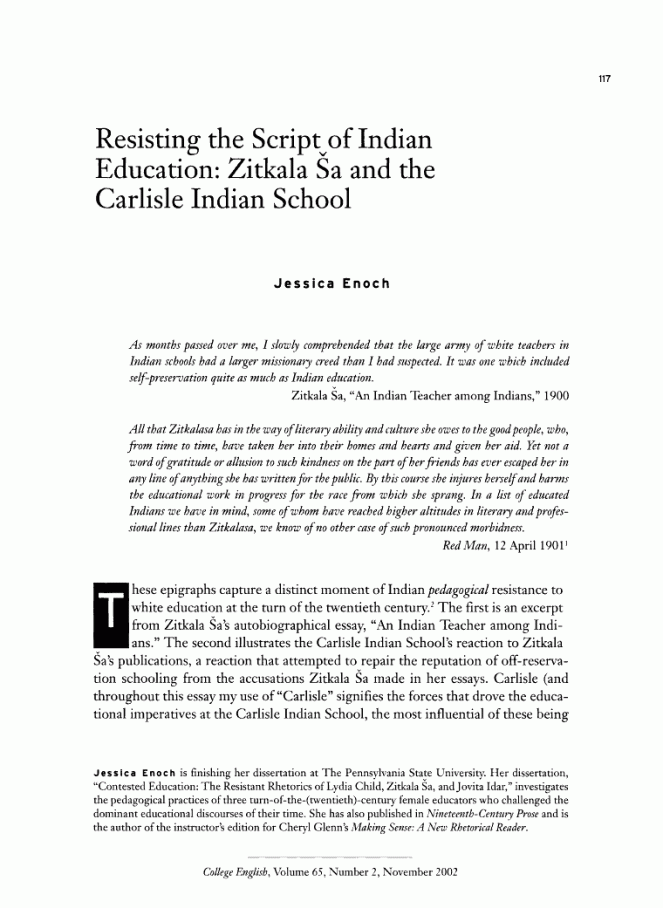
In this article, the author highlights the pedagogical resistance by comparing Zitkala-Sa’s articles and the articles written by the Carlisle school. Zitkala-Sa questions about the education system of the Carlisle school, where they plan to civilize the Indian savages and transform them into self-sufficient individuals. Zitkala-Sa claims “inherent right and ability of Indian people to determine their own communicative needs and desires.” She mentions that she was thankful for the education that she received but at the same time she felt “homeless, penniless, and even without a name!” Zitkala-Sa stands from the Indian point of view to argue that the Carlisle school should not separate Indian children’s physics and education apart.
I found that the points that highlighted from this article have a strong connection with “Impressions of an Indian Childhood” and “The School Days of an Indian Girl” It is essential to keep questioning and challenging the world. Even though since Zitkala-Sa was young, her mother told her multiple times that paleface are not good. When she and her mother at the river, her mother tells her, “If the paleface does not take away from us the river we drink.” Her mother is basically trying to implant an idea deep in her mind–do not try to have connections with whites and they are not as good as you think. To be honest, in general, I think it is not common for a person to question the idea that he or her parents implanted for him or her when they were young. Normally, people will believe in it since the thing has been in their mind for years. Unlike the majority of people, she is very interested in the idea that her mother implanted in her and she has the desire to question and challenge this idea in order to get to know more.
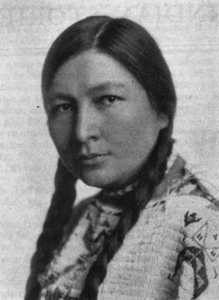
After she goes to school, she starts to notice some physical differences between herself and the paleface. she has to follow many rules and try many new things that she feels uncomfortable with. She was forced to cut her long hair which makes her cries. She also needs to adjust to her new clothes and shoes. Even though she does not feel good with the new things, she has no choice but to accept it. This part of the reading which connected with the article, she receives the education, but lost her culture and home.
In the novel, she struggles with many things, such as new places, dealing with paleface, education… Personally, I really admire her and she is also someone that I look up to because she is the first person who braves enough to get to know and accept the outside world from the Indian perspective. She serves as a bridge between two cultures, two groups of people, and two worlds.
Spark
Not sure if any of you recognize this memorial statue in Washington DC?
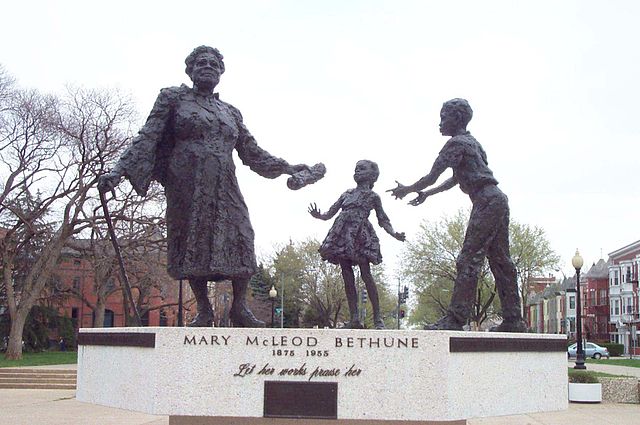
Or this postage stamp?
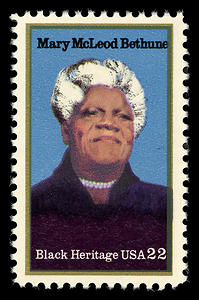
Both the statue and the postage stamp are made to celebrate the life of an African American woman, Mary McLeod Bethune.

I found an article from the National Women’s History Museum site entitled “The Education of Young Black Girls” This article highlights the lady named Mary McLeod Bethune, who is an educator, civil rights activist, and political advisor to multiple US presidents. Bethune has dedicated her life to the struggle for justice, politics, and young generation’s education.
Surprisingly, Mary McLeod Bethune is a daughter of a former slave. She was born in South Carolina in 1875. Her childhood was not easy at all due to her slave family. Her mother has to work for her former owner until she could buy the land on which the family grew cotton. By age nine, Bethune could pick 250 pounds of cotton a day.
Her difficult childhood pushes her to make changes for the future, which I personally related her to Harriet a lot since they both coming from a slave family. Unlike Harriet, her situation is much better. She does not need to work for someone else, instead, she graduated from a boarding school in North Carolina. Soon after that, she becomes an educator. Later on, she opened a boarding school, the Daytona Beach Literary and Industrial School for Training Negro Girls. In her school, she promotes the “dual purpose that Bethune envisioned: to teach both academic and practical skills to black girls.” She teaches the students about their own human rights, such as voting rights, speech rights. Eventually, Bethune’s school became a college. She knows that it is very important to provide education for the young generations because education means unlimited opportunities and chances. This college is actually still existed until now. Under “resources”, the writing center and the residential area are named after her.
The article also points out that, “Bethune encouraged her students and blacks in the Daytona community to ‘exercise their voting power’ and ‘to get involved’ with elections and campaigns. She believed racial uplift started with the education of black girls and the instruction she provided her students with became ‘a prerequisite for the full participation of black women in public life and for their recognition as worthy women.’”
Not just education, Bethune also fights for racial and gender equality, she founded numerous organization which helps women to gain the rights to vote in 1920. In 1924, she was elected president of the National Association of Colored Women’s Clubs, and in 1935, she became the founding president of the National Council of Negro Women. In 1936, Bethune became the highest ranking African American woman in government when President Franklin Roosevelt named her director of Negro Affairs of the National Youth Administration, where she remained until 1944.
For me, I think Bethune is such a powerful woman and I look at her as a role model. She enacts change through action, makes influence of the society, and changes the history. I think that she was so brave to stand up for women’s rights and challenge the society in order to get what they want. As women, we want equality with men and we also want rights and protections. We want to show the world, what a man can do, a woman can do too.
Blog Post #11: Create a Cover Art-Incidents in the Life of a Slave Girl
I searched online to see the cover arts of this novel, and I saw many versions of it. Here are some of them that I found and I think they are all very meaningful.



image source from left to right: Left, Middle, Right
Even though there are many different versions, I noticed that one of the cover arts which portrayed an old fine lady, Harriet, sitting on the chair with a fine pose. Nothing extreme by looking at her facial expressions but a smile. To be honest, I enjoy this cover art the most and I think this cover art perfectly represent the entire novel and Harriet’s journey.
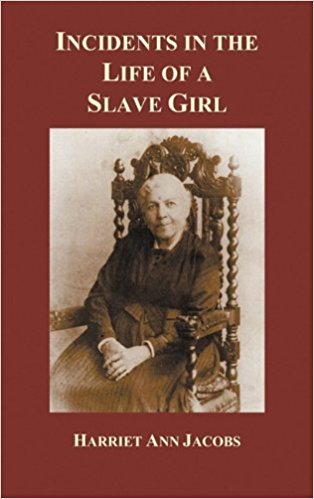
As I discussed in the previous blog (link to blog #9), I pointed out that Harriet is very calm when dealing with all kinds of threats that she faces. Almost every time, when threats or challenges come to her, she never scares them, instead she deals with it by using the gifts of her intelligent, confident, and calm. If Harriet rejects and fights with Dr. Flint, she might not be able to live any longer. I think Harriet is very intelligent, she is good at analysis her current situation. She knows that she is not able to take revenge for now, but she finds other ways to protect herself–goes to Mr. Sands. Her clam not only prevents her from Dr. Flint’s sexual assault but also protects her in many different ways. Therefore, I think the facial expression on the cover art is worthwhile for her reader to discover the meaning behind it.
Personally, I do not think that I can come up with a better cover art for this novel. Since I am very bad at drawing, I tried to use images in the public domain and photoshopped them together to get what I want. This is the cover art that I came up with:

image source from left to right: Left, Middle, Right.
In this cover art, the girl represents Harriet. Her hands are tied up by ropes which explains her identity as a slave girl. This girl is portrayed naked which explains that young slave girl just like Harriet can easily suffer sexual assaults from their master and they have no control of their own body. The girl in my cover art has messy hair and she bends her hand into her chest which explains Harriet suffered many tortures both physically and mentally but she face them with calm and silence. Just as Harriet says at the beginning, “I am aware that some of my adventures may seem incredible; but they are, nevertheless, strictly true.” In the top right corner, I photoshopped the sun is rising and a girl is enjoying the sunshine which represents Harriet escapes to the north and gets to gain her own freedom.
Blog Post #10: In Depth Reading-Incidents in the Life of a Slave Girl
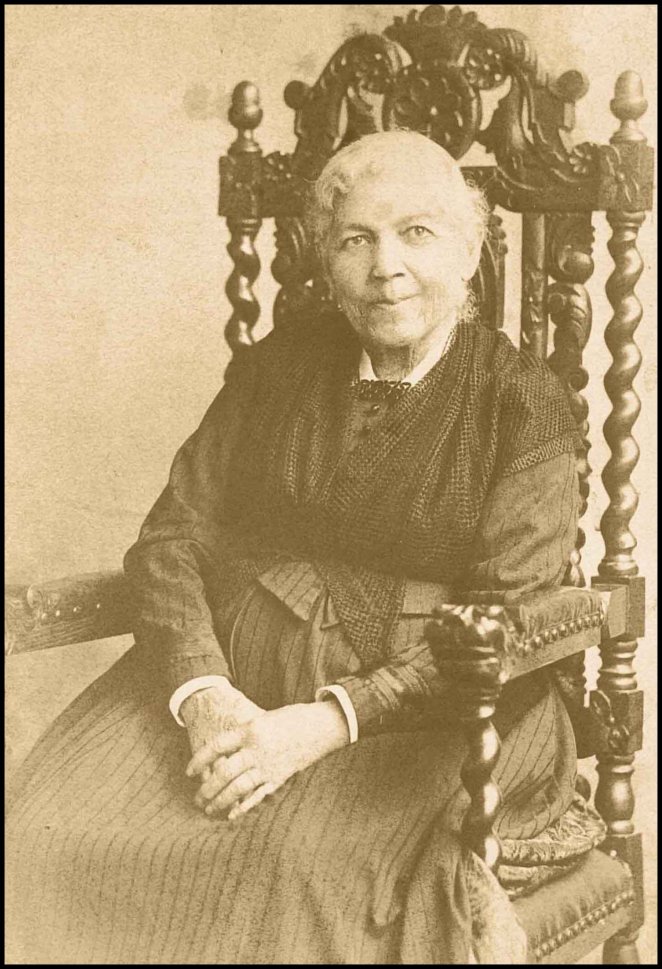
image source: birthtouch.com
Two chapters “Another link to life” and “Scenes at the plantation” the Incidents in the life of a slave girl drew my attention. These two chapters discuss the birth of Harriet’s second child, Ellen, and the beginning of Harriet’s escape. The plot of these two chapters is very intensive and also makes me think about who are the victims of slavery and the harm caused by slavery to women.
In Chapter Thirteen, another link to life, talks about after Harriet had her second baby Ellen, she is very upset about her second child is a girl. Harriet says, “they have wrongs, and sufferings, and mortifications peculiarly their own.” Both her children Benjamin and Ellen cannot name after their father, Mr. Sands due to the rule, children of a slave are also slaves, no matter the status of their father. Harriet feels ashamed about it.
I was very moved by this passage. Even though I am not a mother, I can totally understand Harriet’s feeling. Harriet, as a slave, she knows the feeling of lack of freedom and liberty deeply from her heart. Therefore, she does not want to see that her children become slaves and suffer what she suffered or even more. As a mother, seeing her children suffering is the most painful thing in the world, which she points out at the beginning of Chapter Fourteen, “Hitherto, I had suffered alone; now, my little one was to be treated as a slave.”Furthermore, Harriet is very upset, especially for Ellen. As a slave girl, it is impossible for Ellen to remind virtue. Just as what Dr. Flint tells Harriet in earlier this novel, “ When he told me that I was made for his use, made to obey his command in every thing; that I was nothing but a slave, whose will must and should surrender to his, never before had my puny arm felt half so strong.”
While the idea of slavery is horrible for both men and women, but women and young slave girls are the ones who suffer the most. Their body is not controlled by themselves, but by their master. Their masters view them as not only a slave but also a sexual object of their entertainment. There is a high chance for women slaves to be harassed and insulted by their master. Surprisingly, in that particular time period, masters own the body of slaves as their legal properties. Due to the sexual desires of their master, it is nearly impossible for women slaves remind pure and virtuous. Thus, Harriet claims that she would rather see her children dead than owned by Dr. Flint.
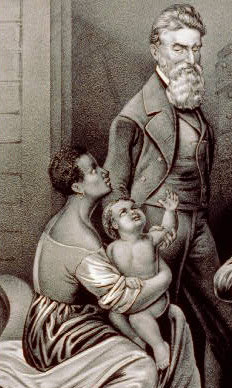
image source: kchhetri7iths.wordpress.com
To prevent Harriet’s children and herself fall into the control of Dr. Flint, she made a bold decision: escape. “I knew the doom that awaited my fair baby in slavery, and I determined to save her from it, or perish in the attempt.” At first, her grandmother tries to convince her to give up the idea of escape due to the high degree of difficulty and a high chance of failure. However, Harriet knows the how much caused by slavery she and her children may receive, she is very determined about escaping, “My courage failed me, in view of the sorrow I should bring on that faithful, loving old heart. I promised that I would try longer, and that I would take nothing out of her house without her knowledge.”
Harriet and her children as slaves are definitely the victims of slavery. In my point of view, even though Dr. Flint is the master of slaves, he is also the victim of slavery. Dr. Flint grows his sexual desire toward Harriet since she was very young. While Harriet is pregnant with her children, Dr. Flint’s behavior becomes abnormal. After Harriet escapes, he keeps looking for her for a long time period. Dr. Flint’s attitude towards Harriet gradually becomes pathologically weird. All in all, the slaves are definitely harmed by Slavery at the same time there are negative effects to the slave owners as well.

